-
If you are posting pictures, and they aren't posting in the correct orientation, please flush your browser cache and try again.
Edge
Safari/iOS
Chrome
You are using an out of date browser. It may not display this or other websites correctly.
You should upgrade or use an alternative browser.
You should upgrade or use an alternative browser.
Tar River SAYA-507 No Till Drill
- Thread starter breddick
- Start date
Hoytvectrix
5 year old buck +
Has anyone fabricated their own settings plate for their Tar River?
We bought one last summer and I think the only thing I was disappointed with was the need to calibrate for every change in seed due to the inaccuracy of the setting adjustment. It is all but useless to have any settings saved currently because the setting values are not accurate enough, or their is enough play in the tightener adjustment to where it could not be trusted across calibrations.
We used to rent a Great Plains from the local NRCS office and even though you needed to calibrate every time, it was still helpful to have past settings to start from instead of just wildly guessing.
We bought one last summer and I think the only thing I was disappointed with was the need to calibrate for every change in seed due to the inaccuracy of the setting adjustment. It is all but useless to have any settings saved currently because the setting values are not accurate enough, or their is enough play in the tightener adjustment to where it could not be trusted across calibrations.
We used to rent a Great Plains from the local NRCS office and even though you needed to calibrate every time, it was still helpful to have past settings to start from instead of just wildly guessing.
Foggy47
5 year old buck +
I operated a Saya 505 for two seasons. I spent some time getting those seed cups to be of equal openings across the entire drill. I found it was easier to measure the openings with a tape measure inside the hopper to make them even. This is not of value after putting seed in the hopper (obviously) but it might prove to be a better starting point before loading future seeds. I did not save any notes on my Tar River......when I changed to a Great Plains. Now I keep a book of settings notes on various seed mixes that I have used. I normally can get pretty close with the prior settings.....but I often tweak the setting after an acre or so. I do allot of calibrating tho.......and collect the seeds dropped into two large under-the-bed plastic containers. That makes it pretty quick....as compared to disconnecting hoses - which is a huge hassle. I did save a pic of my worksheet.Has anyone fabricated their own settings plate for their Tar River?
We bought one last summer and I think the only thing I was disappointed with was the need to calibrate for every change in seed due to the inaccuracy of the setting adjustment. It is all but useless to have any settings saved currently because the setting values are not accurate enough, or their is enough play in the tightener adjustment to where it could not be trusted across calibrations.
We used to rent a Great Plains from the local NRCS office and even though you needed to calibrate every time, it was still helpful to have past settings to start from instead of just wildly guessing.
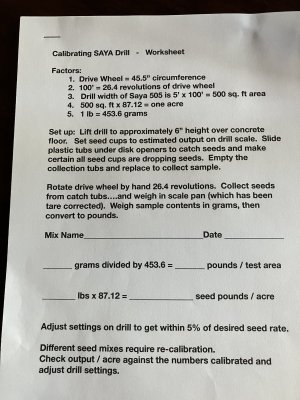
Foggy47
5 year old buck +
Found a pic of the long tubs I used to catch seeds. I think I was just catching two rows at this point in time. Now I do the whole drill now via two long tubs to catch all the rows. That makes the job go pretty quick. In the pic shown.....I used a large socket and tried turning the wheel via turning the tool. I think I reverted to just spinning the drive wheel. I must have changed my sample size too....as I see it's different here than said above. Hmmm. dont remember. Not sure if you are aware of the Facebook page on the Tar River drills? Those guys have develpoed lots of data on settings that you may find valuable. Lots to read on set up there too. I was one of the early adopters....and used to contribute quite a bit to that page.
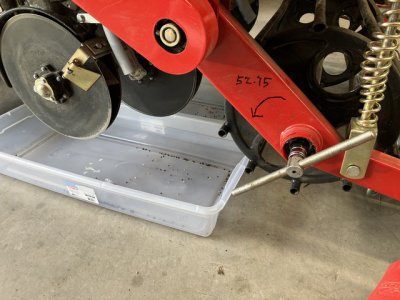

356
5 year old buck +
The Facebook page is filled with good information. Unfortunately, there are a few trolls on the page, but the good out weights the bad on the site. I use a 6’ long piece of rain gutter to catch the seed for calibration. It is easy to dump into the coffee bin I use for weighing. So far I am very pleased with the Tar River. The plots drilled late last fall are looking great despite heavy browse pressure and provided early season browse for deer and turkey.Found a pic of the long tubs I used to catch seeds. I think I was just catching two rows at this point in time. Now I do the whole drill now via two long tubs to catch all the rows. That makes the job go pretty quick. In the pic shown.....I used a large socket and tried turning the wheel via turning the tool. I think I reverted to just spinning the drive wheel. I must have changed my sample size too....as I see it's different here than said above. Hmmm. dont remember. Not sure if you are aware of the Facebook page on the Tar River drills? Those guys have develpoed lots of data on settings that you may find valuable. Lots to read on set up there too. I was one of the early adopters....and used to contribute quite a bit to that page.
View attachment 77053
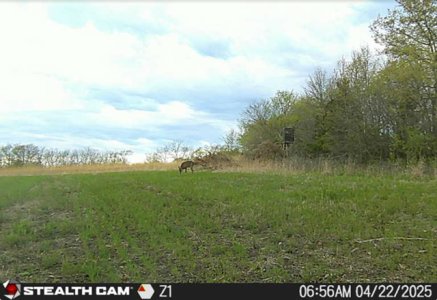
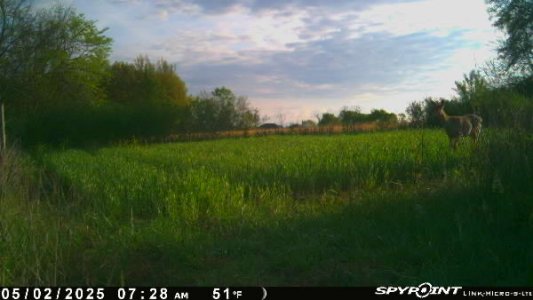
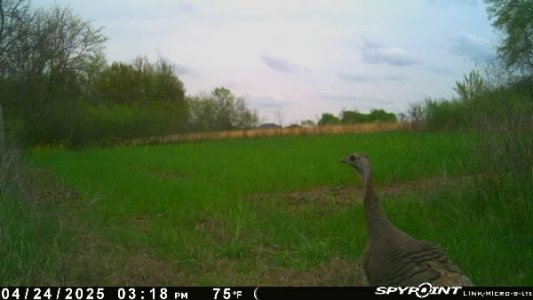
Buckhunter10
5 year old buck +
I have made a few adjustments to ours. I do around 40+ acres a year through it. It's not the best drill, but I would say I have made my money worth it already.
I also put this together on how I calibrate my 507 - this is really easy to do (IMO) and will work on any drill.
How To Calibrate A Tar River Drill
🌾 Seed Drill Calibration Notes Drill Width (10 turns) • 78 inches (6.5 feet) Drive Wheel • Diameter: 15 inches • Circumference:15 in×π≈47 inches15 \, \text{in} × π ≈ 47 \, \text{inches}15in×π≈47inches 📐 Acreage & Wheel Rotations • 1 acre = 43,560 sq ft • Drill width = 6.5 ft • Linear feet per...
vitalizeseed.com
I hope this helps someone!
Buckhunter10
5 year old buck +
Here is how I added weight, and it has held up well. Not fancy, but it does work. Again, I hope this helps someone!
Hoytvectrix
5 year old buck +
Thanks for the videos @Buckhunter10 .
So is everyone just starting from scratch every time they change out a seed source? I sometimes like to make adjustments in the field and it would be great if someone had an improvement on the settings to take advantage of these changes for next time. Currently, you have to start from scratch for every drilling and the calibration process really slows down the planting.
So is everyone just starting from scratch every time they change out a seed source? I sometimes like to make adjustments in the field and it would be great if someone had an improvement on the settings to take advantage of these changes for next time. Currently, you have to start from scratch for every drilling and the calibration process really slows down the planting.
Buckhunter10
5 year old buck +
I have started every time - if I hated one thing on the drill - it’s the BS “guage” for monitoring seed opening. I did use a silver sharpie on the gear so I can quickly see where the opening is relative to the previous position so I know if I need to move it in or out. I suppose - one could do that and measure that distance and then if you have a tape measure with you- you could forget the gauge and measure that distance each time or mark that down so you know for beans it’s “1 1/4 inch showing”. I’ll need to take pics to explain better.Thanks for the videos @Buckhunter10 .
So is everyone just starting from scratch every time they change out a seed source? I sometimes like to make adjustments in the field and it would be great if someone had an improvement on the settings to take advantage of these changes for next time. Currently, you have to start from scratch for every drilling and the calibration process really slows down the planting.
Mibowhunter91
5 year old buck +
So looking for something input from you guys using the drill. Life got in the way this spring and time flew by I had plans to get a grassy field edge the farmer leaves under control and planted into a cover crop to drill into a fall plot but it never happened. Now the big edge is about 4’ tall grass I’m thinking I’d be better off brush chopping it asap then hit it was some gly to kill it all off and if needed hit it again right before drilling a fall blend. Worst case it doesn’t take and just drill rye in September. Am I on the right track?
Sent from my iPhone using Tapatalk
Sent from my iPhone using Tapatalk
Buckhunter10
5 year old buck +
I’d drill right through the grass. Mowing and then drilling (in my experience) is asking for clogged double discs. I’d just drill through it - spray it and pray for rain.So looking for something input from you guys using the drill. Life got in the way this spring and time flew by I had plans to get a grassy field edge the farmer leaves under control and planted into a cover crop to drill into a fall plot but it never happened. Now the big edge is about 4’ tall grass I’m thinking I’d be better off brush chopping it asap then hit it was some gly to kill it all off and if needed hit it again right before drilling a fall blend. Worst case it doesn’t take and just drill rye in September. Am I on the right track?
Sent from my iPhone using Tapatalk
Foggy47
5 year old buck +
I've done both.....and had good success with either. But if you have real heavy wet grass.....you may be better to drill first....then spray. Mowing is optional.....depedning on weeds and need for mulch. Sometimes there is not a real clear answer.....as conditions and future conditions can change. I.E. Is it gonna rain soon?So looking for something input from you guys using the drill. Life got in the way this spring and time flew by I had plans to get a grassy field edge the farmer leaves under control and planted into a cover crop to drill into a fall plot but it never happened. Now the big edge is about 4’ tall grass I’m thinking I’d be better off brush chopping it asap then hit it was some gly to kill it all off and if needed hit it again right before drilling a fall blend. Worst case it doesn’t take and just drill rye in September. Am I on the right track?
Sent from my iPhone using Tapatalk
Mibowhunter91
5 year old buck +
Ideally I’d wait for rain either way it is river bottom ground that’s is softer. Your guys advice is kinda pushing me towards my gut that I’m over thinking it just get the grass killed and drilled and hope for rain if I get a chance maybe I’ll chop some of it and leave some to test out if one takes off better than the other
Sent from my iPhone using Tapatalk
Sent from my iPhone using Tapatalk
356
5 year old buck +
I would terminate the grass with herbicide, then come back and drill into the dead grass. Generally the fall blend will be drilled in August, so the grass should be nice and dead by that time. I did this to a plot last year. The drought kept the fall plot from growing at the time. Come spring, the fall plot came up great—the point I am making is that the Tar River did a great job of drilling the seeds into 4’ grass that had been terminated. I can’t blame the drill on the fact the “100% chance of 1” of rain” turned out to be no rain in eight weeks.
Mibowhunter91
5 year old buck +
I would terminate the grass with herbicide, then come back and drill into the dead grass. Generally the fall blend will be drilled in August, so the grass should be nice and dead by that time. I did this to a plot last year. The drought kept the fall plot from growing at the time. Come spring, the fall plot came up great—the point I am making is that the Tar River did a great job of drilling the seeds into 4’ grass that had been terminated. I can’t blame the drill on the fact the “100% chance of 1” of rain” turned out to be no rain in eight weeks.
That’s always my struggle as well! I know we’ll get rains closer to fall so my fall back will be some grains later in September. I do know as most of you guys that not working the dirt to bare soil has really helped when we get dry spells after they germinate. I just haven’t tried it with that much grass yet
Sent from my iPhone using Tapatalk
356
5 year old buck +
Drilling into the grass will work. Based on posting on the Tar River facebook group, a few users had issued with grass getting caught and accumulating in the rear roller….I tried to check mine each pass. On one pass some Johnson grass along a field edge had accumulated on the roller, and I removed it….no more problems the rest of the day. It not removed, I have seen pictures of bundles of grass so thick that it pulled the roller out of the frame. That is user error, not drill error, IMO. Let us know your results.That’s always my struggle as well! I know we’ll get rains closer to fall so my fall back will be some grains later in September. I do know as most of you guys that not working the dirt to bare soil has really helped when we get dry spells after they germinate. I just haven’t tried it with that much grass yet
Sent from my iPhone using Tapatalk
Last edited:
Foggy47
5 year old buck +
I had my Tar River Saya 505 for two seasons. I really wondered how well that roller would perform with lots of weeds and grass. I cannot think of any issues I had with wrapping or performance. Same goes for those "flaps".....which work pretty well for the purpose.....in spite of being a bit fragile (IMO).Drilling into the grass will work. Based on posting on the Tar River facebook group, a few users had issued with grass getting caught and accumulating in the rear roller….I tried to check mine each pass. One one pass some Johnson grass along a field edge had accumulated on the roller, and I removed it….no more problems the rest of the day. It not removed, I have seen pictures of bundles of grass so thick that it pulled the roller out of the frame. That is user error, not drill error, IMO. Let us know your results.
The newer Tar River products seem to have solved some of these issues with the wheels on the back that replace the flaps. That company has listened to the early owners and has made a number of improvements over time.....from what I have read. Kinda refreshing to see a company that listens. Herd and Flimco should try that plan....grin.
Buckhunter10
5 year old buck +
Buckhunter10
5 year old buck +
For those who didn’t want to watch the video - here are additional pictures and weight rack update. I added about 700lbs that actually fits on the rack. We built a makeshift frame (scrap wood in barn) that’ll hold it down and I’ll strap it as well. This will allow me to easily remove weight if needed vs. a large cement block. Both ideas will work but I wanted to go this route.
As always - I hope this helps someone!
For the rack -
I used
Sterilite Small Storage Bin, 20 Quart Clear Plastic
These fit perfectly - 2by2
I filled with quickcrete - drilled holes in quickcrete after 12 hours of cure. I then filled holes with water and more quickcrete to top of bins.
I left lids on but not snapped down so the concrete can cure. I left it sit for around 7 days.
Each bin held around 80lbs of dry quickcrete then water.
I wrapped the bins in filament tape (stronger than other tape) and then ran just standard duct tape around the corners and such.
All in I had maybe 100-125 into the weights. They were stable and heavy.
As always. Hope this helps someone.
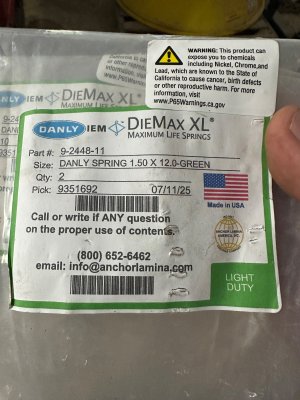
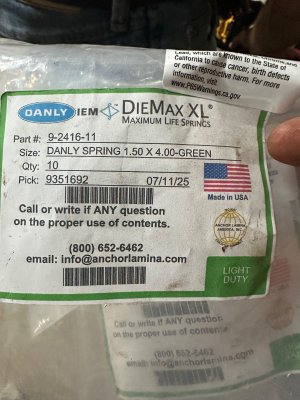
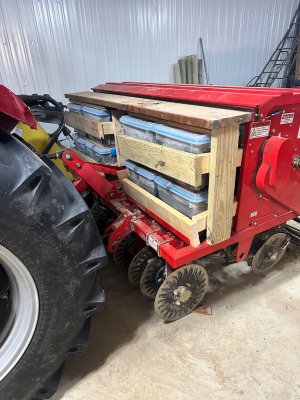
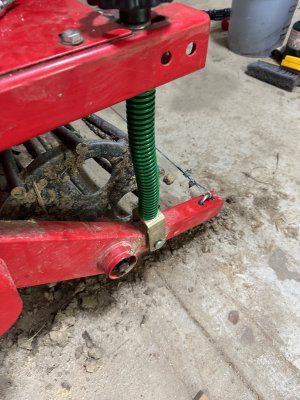
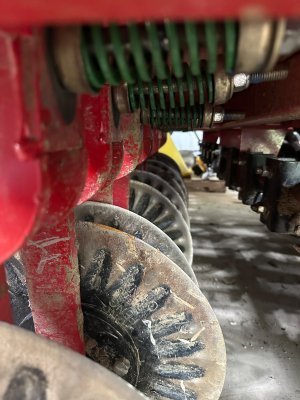
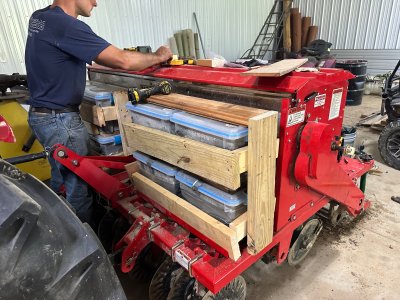
As always - I hope this helps someone!
For the rack -
I used
Sterilite Small Storage Bin, 20 Quart Clear Plastic
These fit perfectly - 2by2
I filled with quickcrete - drilled holes in quickcrete after 12 hours of cure. I then filled holes with water and more quickcrete to top of bins.
I left lids on but not snapped down so the concrete can cure. I left it sit for around 7 days.
Each bin held around 80lbs of dry quickcrete then water.
I wrapped the bins in filament tape (stronger than other tape) and then ran just standard duct tape around the corners and such.
All in I had maybe 100-125 into the weights. They were stable and heavy.
As always. Hope this helps someone.






356
5 year old buck +
Tar River Reflections: Year 3
I’ve been using the Tar River Saya 505 now for three years. My first season of use was with a John Deere 3E series. This series has marginal hydraulics, but it worked and the soy-Milo field I planted germinated well.
Last year’s plots were a bust due to the drought—however, the rows looked great, it just that they never got the rain needed to realize their potential. This spring those same plots blossomed and the drill lines were clearly evident.
This year I planted soybeans, and the bean crop for deer looks as good as the commercial beans next to them. The past two years I have been using a John Deere 5E, which is overkill for the drill, but makes life easy.
Keys to making this drill work great are:
1) Weight…I am using cinder blocks and cement bags. The drill comes with weight frames, so it is easy to add based on ground conditions. I currently run 250#. I will note that with the JD3E tractor I was not able to add weight, and the plots still looked great.
2) Hydraulic top link…This allows from the seat adjustment to the coulters.
3) The small seed box is great for a variety of seeds, but works especially well for fall blends. The front box is perfect for soy, corn and other larger seeds.
4) Watch the stuff Buckhunter posts and join the Tar River Saya 505/507/509 Facebook page. You’ll have to sift through some garbage, but if you focus on real-world users, it will help you get the most from this economical (but not cheap) NT drills. This forum has some great post as well. Foggy47 was an early adopter and has some very helpful posts.
2023 Milo Plot
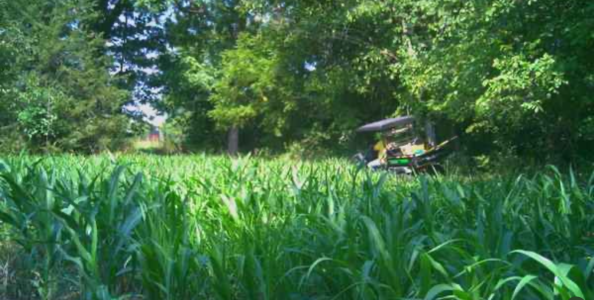
2024 Drought Impacted Fall Plot
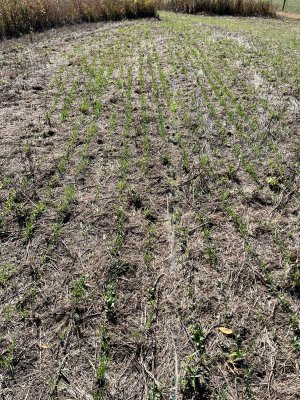
2025 Soybeans (you can't blame the drill for the weeds....)
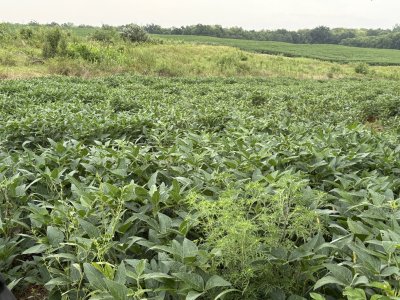
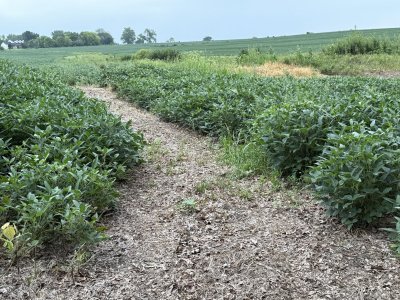
Beans on the left--commerial ag plants by our cash/rent farmer. Beans on the right, planted with Tar River 505.
I’ve been using the Tar River Saya 505 now for three years. My first season of use was with a John Deere 3E series. This series has marginal hydraulics, but it worked and the soy-Milo field I planted germinated well.
Last year’s plots were a bust due to the drought—however, the rows looked great, it just that they never got the rain needed to realize their potential. This spring those same plots blossomed and the drill lines were clearly evident.
This year I planted soybeans, and the bean crop for deer looks as good as the commercial beans next to them. The past two years I have been using a John Deere 5E, which is overkill for the drill, but makes life easy.
Keys to making this drill work great are:
1) Weight…I am using cinder blocks and cement bags. The drill comes with weight frames, so it is easy to add based on ground conditions. I currently run 250#. I will note that with the JD3E tractor I was not able to add weight, and the plots still looked great.
2) Hydraulic top link…This allows from the seat adjustment to the coulters.
3) The small seed box is great for a variety of seeds, but works especially well for fall blends. The front box is perfect for soy, corn and other larger seeds.
4) Watch the stuff Buckhunter posts and join the Tar River Saya 505/507/509 Facebook page. You’ll have to sift through some garbage, but if you focus on real-world users, it will help you get the most from this economical (but not cheap) NT drills. This forum has some great post as well. Foggy47 was an early adopter and has some very helpful posts.
2023 Milo Plot

2024 Drought Impacted Fall Plot

2025 Soybeans (you can't blame the drill for the weeds....)


Beans on the left--commerial ag plants by our cash/rent farmer. Beans on the right, planted with Tar River 505.
Similar threads
- Replies
- 3
- Views
- 544

